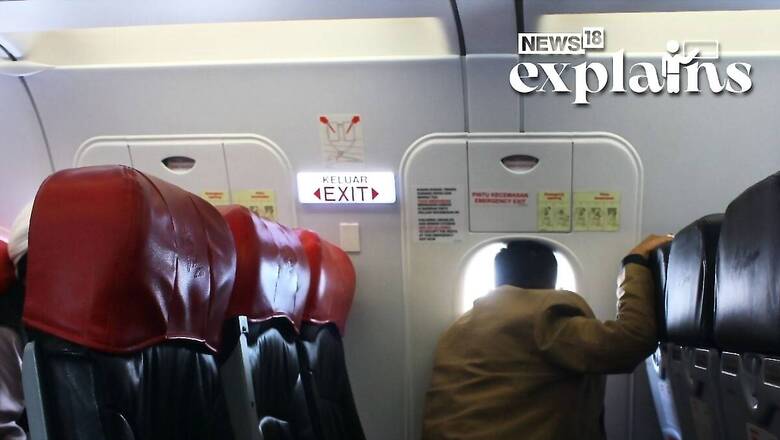
views
South Korean authorities stated on Saturday that a man who opened an emergency exit on an Asiana Airlines flight during the flight felt a sense of suffocation and had a strong desire to disembark quickly. The incident occurred as the aircraft, carrying nearly 200 passengers, was approaching Daegu International Airport, approximately 240 kilometers (149 miles) southeast of Seoul, on a domestic flight.
According to the police, the incident took place when the plane was approximately 200 meters (650 feet) above the ground. The passenger responsible, described as a man in his 30s, opened the exit door. The individual was later taken into custody by the Daegu police for questioning, during which he revealed that the recent loss of his job had caused him considerable stress.
A passenger opened an emergency exit door during a flight in South Korea, forcing the crew to land while it was still open.Air blew through the cabin of the Asiana Airlines jet, slightly injuring 12 people. pic.twitter.com/Nl8HqXeiLb
— The Associated Press (@AP) May 26, 2023
An AFP report quoted a detective from the Daegu police, who stated that the passenger believed the flight duration was longer than expected and experienced feelings of suffocation inside the cabin. The detective further added that the passenger expressed a strong desire to leave the aircraft swiftly.
The passenger now faces potential imprisonment for up to 10 years due to his violation of aviation safety laws. Videos captured by fellow passengers showcased the forceful winds entering the cabin through the open door, causing seat-backs and passengers’ hair to be whipped around, leading to surprise and concern among some individuals. Another video circulated on social media depicted passengers in the emergency exit row being buffeted by the strong winds.
Following the incident, a dozen passengers were transported to a hospital due to breathing difficulties, although no serious injuries or significant damage occurred, as confirmed by the transport ministry. A 44-year-old passenger, recounting the chaos, informed Yonhap news agency that individuals near the door seemed to faint one after another, while flight attendants urgently sought medical assistance from onboard doctors. The passenger also expressed his fear, believing that the plane might explode and that his life was in danger.
A representative from the transport ministry informed AFP that this incident appeared to be the first of its kind in the history of Korean aviation. Experts have acknowledged South Korea’s aviation industry for maintaining a strong safety record.
Amid the scary incident, let’s learn a little more about airplane doors opening mid-air, cabin depressurizing and whether you should worry:
Can Airplane Doors Actually be Opened Mid-air?
Science says no. Or at least, not too far up in the air. While the scenario of a drunken or disturbed passenger opening an airplane door mid-flight is certainly unsettling, it’s important to note that the actual risk of such an event occurring is negligible.
As an aircraft ascends to higher altitudes, the atmospheric pressure decreases according to Boyle’s Law. This decrease in pressure makes it harder for oxygen molecules to enter our bloodstream, resulting in a reduced availability of oxygen. Beyond 18,000 feet, the oxygen intake is insufficient to sustain brain function, leading to unconsciousness within approximately 30 minutes. Since commercial airliners typically operate at altitudes between 30,000 and 43,000 feet, the cabin must be pressurized to ensure a survivable environment. This is why oxygen masks deploy during depressurization events, and passengers are instructed to attend to their own masks before assisting others, as the onset of hypoxia (oxygen deprivation) can cause rapid delirium and unconsciousness, as per a report by WIRED.
Now, how does this relate to airplane doors? The pressurization within the cabin effectively seals the doors shut. To understand this, imagine the door as a large plug in a bathtub drain, the report explains. Most aircraft exits are designed to open inward, taking advantage of the “plug hole effect.” If you observe the door closely when disembarking, you’ll notice its interesting tapered shape. This design allows the door to fit snugly into its designated opening, resembling a plug. When the cabin crew opens the door, they employ a specific technique or sideways shuffle to dislodge the door from its plugged position.
Therefore, while the fear of an airplane door opening mid-flight is understandable, it’s crucial to recognize that modern aircraft are equipped with robust door mechanisms and cabin pressurization systems that effectively seal the doors shut, ensuring passenger safety throughout the flight.
In the recent case, the passenger opened the door when the plane was just 650 feet above the ground, making it easy to open the door due to a lesser difference in pressure.
AFP contributed to this report


















Comments
0 comment